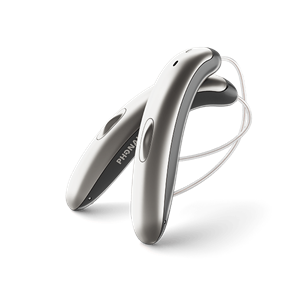Behind-the-Ear (BTE) | Connect Hearing
This hearing aid is traditionally the most powerful and rests on the back of the outer ear.
The most familiar hearing aid style, Behind-The-Ear (BTE) aids, are housed in a durable case that rests on the back of the outer ear. These aids are suitable for the widest range of hearing loss, including profound hearing loss. While the larger size BTEs allow for more power and features, the smallest ones, mini BTEs, are practically invisible when worn.
Description
Behind-the-ear (BTE) hearing aids are versatile devices suitable for a wide range of hearing loss, and are available in various sizes.
With the BTE models, sound is transmitted into the ear through a very discreet tube, which leads into a customized earmold. Because they are larger, BTE models have more space for electronic components than other types of hearing aids, giving them more room to house additional features and deliver advanced performance for a wider range of hearing loss types. Additionally, BTEs are comfortable, easy to mold, and easy for caretakers to assist with and maneuver.
Advantages
Easy to handle, insert and adjust
Suitable for all levels of hearing loss
Can fit many features
Larger batteries for longer battery life
Space for larger and more powerful batteries
Larger program selection buttons that are easier to operate
Open fitting
Connection to radios and TV sets via an audio shoe, wireless reception via induction, radio and infra-red signals, or Bluetooth
Disadvantages
More visible than smaller models
More sensitive to wind
Less suitable for people who wear eyeglasses
Prevents use of the natural functions of the concha
Less discreet
The structure of BTE devices
The latest hearing aids are small and delicate. This makes them highly discreet. The housings are available in various colors. Water, sweat and dust-resistant models are available for athletes. There are even specially designed hearing aids for swimmers. These work down to a depth of one meter.
Microphone – Picks up sounds and converts them into electrical signals
Amplifier – Increases the volume of the microphone signals and filters out irrelevant sounds
"Loudspeaker“ – Converts electrical signals into acoustic signals
Speech processor – Adjusts signals to the wearer's individual hearing needs
Volume regulator – Lets the wearer control the volume
Ear hook – Connects the hearing aid and the sound tube
Audio input – Picks up signals from other external devices
Disposable or rechargeable battery for the power supply – While disposable batteries can be changed several times, rechargeable batteries last for up to 24 hours with just one charge
The hearing aid is connected to the ear via a sound tube, which ends in a fixing piece, or earpiece/ear shell (earmold). A variation on the classic BTE hearing aid is the external receiver model (receiver-in-canal, or RIC), in which the loudspeaker sits inside the ear, thus transmitting sound directly to the eardrum.
Other behind-the-ear (BTE) hearing aids
External receiver model (receiver-in-canal, or RIC)
The smallest behind-the-ear models are equipped with external receivers and usually also offer wireless functions.Micro-behind-the-ear models
These hearing aids are smaller than normal BTE models and suitable for people with mild to severe hearing loss. They can be worn comfortably behind the ear and come in a wide range of colors, shapes, and styles.Types of In-the-Ear Hearing Aids
In-the-Ear (ITE)
The housing of this hearing aid completely fills the concha. The advantages include a longerbatterylife, the availability of a power version for severe hearing loss, and improved operation.In-the-Canal (ITC)
This is a small and discreet custom model. The hearing aid housing sits in the ear canal, thus only filling half of the concha.Completely-in-Canal (CIC)
The smallest custom model, the CIC offers the ultimate in discretion as it is virtually invisible from the outside. These devices typically have a nylon strand to facilitate removal from the ear.Invisible-in-Canal (IIC)
This subgroup of CIC devices are hearing aids that are worn deep in the ear canal making them completely discreet. Phonak's Lyric is an example of an IIC hearing aid.VAC, WCB, WSIB, WorkSafeBC, ADP & ODSP accepted. *Hearing evaluations/tests are free for customers over the age of 18. Fees may apply where specific testing for employment purposes, reports, a copy of your results or the completion of an application is required. See clinic for full details.



